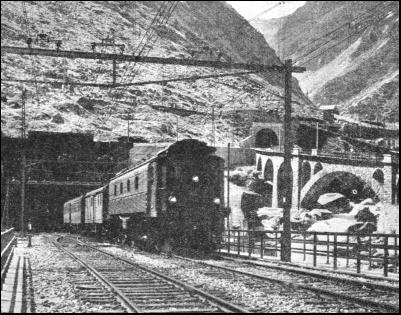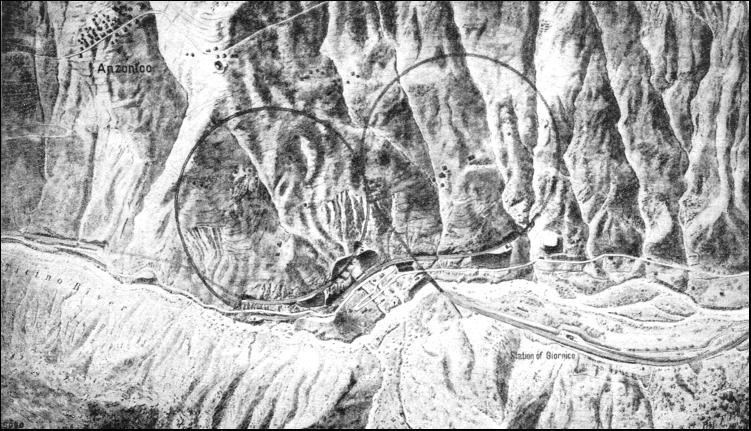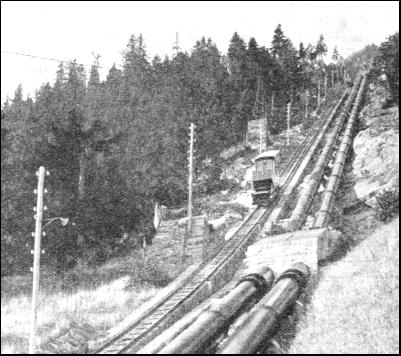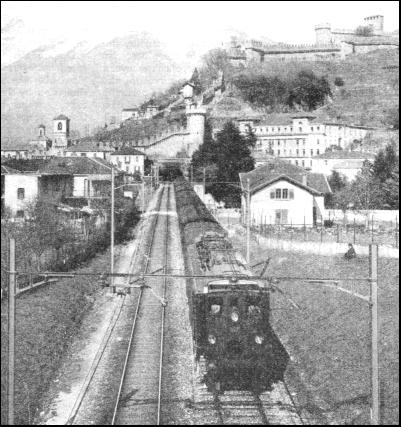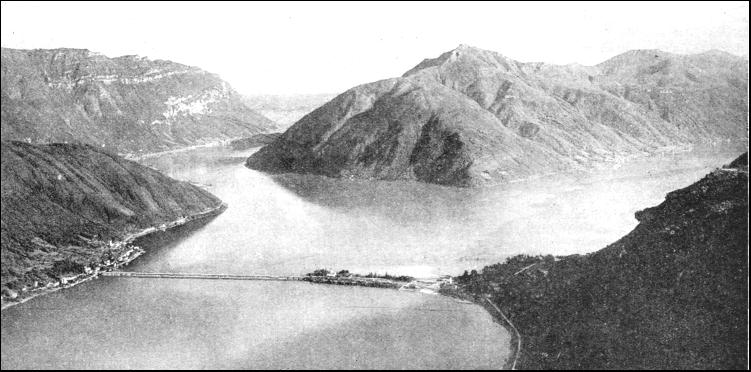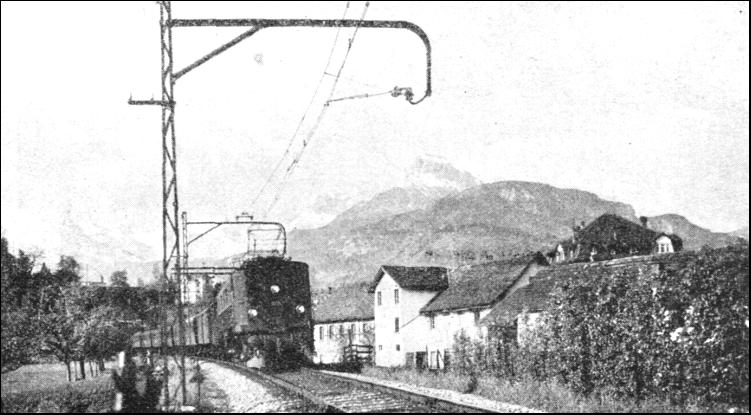|
|
SWITZERLAND, by reason of its central position in Europe, is a focal point of railway communication. Through this small country pass several of the most important of the trans-European main lines. And as the south of Switzerland is practically filled with the great mountain mass of the Alps, it necessarily follows that several of these lines have to find their way through the Alpine chain. The most spectacular feats of engineering have been achieved by two of these main lines cutting across the Alps from north to south, on the way down to Italy. Of these, the older established, and the first Swiss main line to cross the Alps, is the famous St. Gothard Railway. Throughout history the St. Gothard Pass has provided a highway through the Alps. As far back as the thirteenth century, pilgrims to and from Italy used it ; and a hospice for their shelter has existed for over five hundred years on the summit. Following them came the merchants from Basle and Zurich, desiring to form trading alliances with the rich cities of Lombardy, and with Milan in particular. By the fifteenth century an irregular post had been established over the narrow mountain track ; by 1693 this developed into a regular postal service twice a week. Just over a century later the Swiss Republic assumed the responsibility ; by 1820 a road had been made up to Göschenen, and by 1834 the road had been carried over the St. Gothard Pass. In 1842 the postal service started to run every day, and passengers, up to eight in number, were allowed to ride in the post-wagon, or diligence. Thus it was that, with railway communication spreading all over Europe, attention became directed towards the possibility of cutting a railway through from Central Switzerland to North Italy, to provide a direct route, not only from Basle and Zurich, but also from Germany and beyond, into Italy. The far-reaching advantages that would accrue were obvious, but with the limited engineering experience of mountain railway construction then available, the Alps offered a tremendous obstacle to the development of any such scheme.
Up these rugged Alpine valleys, roads could be carried at inclinations as steep as 1 in 10—that is, an ascent of one foot for every ten feet travelled in a forward direction—or even steeper, and horses, given sufficient of them and plenty of time, could negotiate such inclines. But for the efficient working of the railway, especially on main lines over which heavy loads of passengers and freight might be expected to pass, such steepness would be out of the question. Nothing steeper than 1 in 40 or so could be entertained. As these Alpine valleys rise with progressively increasing steepness into the heart of the mountains, it was realized that the point at which it would become impracticable to lift the railway any higher would be reached, a considerable distance away from the crest of the Alps. Recourse to tunnelling would then be imperative, in order to cut through to a valley on the south side of the range which would lead the line down into Italy. It was clear that the tunnel would have to be of greater length than any railway tunnel previously attempted in any country. The increasing importance of the St. Gothard road naturally suggested a similar route for the proposed railway. But the supporters of the St. Gothard Railway met with considerable opposition. A strong body of Swiss opinion favoured a route farther to the east, by way of the Lukmanier Pass ; this would have come up the Rhine valley to Disentis, there turning south through the Lukmanier, and joining at Biasca the Val Leventina, down which passed the St. Gothard road. The Federal authorities, however, finally decided, in 1869, on the St. Gothard route, and events have since proved that in more respects than one they made a very wise decision. Work on this colossal undertaking did not begin until 1872, and it continued for ten years, until the St. Gothard Railway was opened throughout its length. Owing to many and unexpected difficulties, the original estimates were swollen until the final expenditure reached £4,760,000.
To those acquainted with present-day railway constructional costs this appears a remarkably moderate figure in view of the astonishing character of some of the engineering work. Apart from the 9-1/4 miles of the great St. Gothard Tunnel, a further 19-1/4 miles of tunnels, 79 in all, of varying length, seven of them spiral in plan, had to be bored ; 324 bridges, some of them massive viaducts, and all of more than ten metres (32 ft. 10 in.) in span, had to be thrown across gorges, rivers, and smaller streams. An immense amount of blasting had also to take place in order to fashion along the mountain sides the shelves on which the railway was to be laid. Incidentally, by reason of the detours entailed in circumventing Nature's obstacles, and in following the sinuous course of her valleys, the distance of 90 miles from Lucerne to Chiasso, as the crow flies, became 140 miles along the best railway route that could be devised. Lucerne is the starting point of the St. Gothard Railway. The bulk of the traffic passing over this railway has come through Basle, the principal northern traffic gateway of Switzerland. There, in the great Hauptbahnhof, or Central Station, coaches from many European countries—German Mitropa sleeping-cars from Berlin, Dutch vehicles from Amsterdam, Belgian stock from Brussels, and French carriages from Paris and Calais—are marshalled with Swiss stock into cosmopolitan trains. These will presently wind their way, behind powerful electric locomotives, through some of the most magnificent scenery that the world offers to the railway traveller. After passing through the Jura mountains, the south-bound trains from Basle enter the Alpine foothills at Lucerne, and are there reversed for the St. Gothard journey. The station in which this takes place is in itself a witness to tlie fact that the Swiss railway authorities spare no effort to make the station appear as attractive to the traveller as they can make it. Prominently situated on the lake-side, it is a superb pile of architecture, and an ornament to the beautiful and popular town that is fortunate enough to own it. With an electric locomotive—or, more probably two coupled together—at the head of the train, the St. Gothard journey now begins. At the outset, a substantial natural obstacle is presented by the shape of the Lake of Lucerne. This is cruciform ; Lucerne stands at the head of the north-western arm, and the north-eastern arm lies directly athwart the course that the railway should pursue in order to reach the southernmost extremity of the lake. After passing in a long semicircular tunnel under Lucerne, the line is compelled to turn through a right-angle, and is carried along the shore of the north-eastern "bay." Then for a time it leaves the lake altogether, crosses over a narrow neck of land to the Lake of Zug, and passes round the farther side of that most famous of mountain viewpoints—the Rigi—to Arth-Goldau. Here it is joined by a direct route which has come southwards from the city of Zurich, and through coaches from Zurich are attached to the principal trains. Curving round the easternmost end of the Rigi range, the line now turns southwards, and emerges once again on to the Lake of Lucerne at Brunnen. In a direct line Lucerne is only 15 miles away ; but the train has already travelled 24-1/2 miles to reach Brunnen. The southern end of the Lake of Lucerne, known as the Lake of Uri, is its grandest part. The water is pent between great cliffs, themselves backed by high mountains, whose basins enfold the blue-white of beautiful glaciers. Above the railway, and along the cliff on the east side, runs the partly tunnelled Axenstrasse, one of the most magnificent roads in Europe. At the lower level, passing through tunnels, and along a rock-blasted ledge, is located the railway, until the extreme south end of the lake is reached at Flüelen. Opening up ahead, to the right of the shapely cone of the Bristenstock, is the valley of the Reuss, up which the railway is now to pass. Silt brought down in ages past by the rushing river has flattened the mouth of the valley, so that the track is comparatively level until Erstfeld is reached. The line here lies 1,558 ft. above the sea, and 37-1/2 miles from Lucerne ; as yet it has climbed no higher than 108 ft. above the level of the lake. The main gradient now begins. In the next eighteen miles a total rise of 2,082 ft. is to be negotiated. This will lift the railway to an altitude greater than the summit level of Snowdon, 3,571 ft. Therefore, over the whole of this section of line the locomotives have to climb continuously up a gradient which varies between 2.2 and 2.6 per cent—that is to say, from 1 in 45-1/2 to 1 in 37-1/2, and with a general average of 1 in 43-1/2.
When it is realized, by way of comparison, that the worst pitch of the famous English ascent to Shap Summit, in Westmorland, is 1 in 75 for four miles, the difficulty of working heavy traffic up 18 miles at 1 in 43-1/2 may be better appreciated. In the days of steam haulage, of course, the problem was far greater. The passenger was made well aware of it by the vocal efforts of the locomotives, and by the sulphurous fumes which compelled him hastily to shut the windows of his compartment as each tunnel was reached. On leaving Erstfeld, the railway begins climbing steadily on the east side of the valley, until it is high above the valley floor, when it reaches Anisteg. This is in anticipation of the rapid rise of the valley itself, which takes place not far ahead, at a point where the Reuss has forced its way tempestuously down through a narrow ravine. But the position of the line, high up on the mountainside, called for an engineering feat of note above Amsteg, where the Reuss is joined by the rushing Kerstelenbach, coming down the Maderaner Valley from the east. Across this gorge it was necessary to throw an immense two-span steel lattice girder viaduct, carrying the track 178 ft. above the Kerstelenbach. With the two side arches this bridge is 440 ft. across. Owing to the greatly increased weight of the locomotives since electrification came into use, it might have become necessary to replace these great steel spans, but the ingenious Swiss engineers have built inverted bowstring trusses underneath them. This additional support has given the bridge another lease of life. Protected from the danger of avalanches by tunnels with sloping roofs, the line is now carried along the almost perpendicular slopes of the Bristenstock. Close to high waterfalls, which hurl themselves over sharp precipices, the line runs along their ledges, higher and yet higher above the foaming Reuss. Then it swings across from the right to the left of the river by a bridge 256 ft. in altitude above the water. But before many miles have passed, the railway and the river are found to be on closer terms, so rapid has been the rise of the valley floor. And obviously the valley is closing in ahead, and rising more steeply yet. The traveller now asks himself what has been done to keep the railway above the level of the river without increasing the steepness of its ruling gradient ? His question is answered when the train takes a right-hand turn into the mountain-side. Unknown to the traveller, the line is describing a complete spiral turn in the rock. When the train emerges from the tunnel, the traveller finds that he is once again high above the Reuss, but that between him and the river there appears to be another railway. It is the very line over which he was travelling but a few moments before. By this favourite height-gaining device the engineers have lifted the line 115 ft. in altitude during the 1,635-yard circuit of Pfaffensprung spiral tunnel. Soon the railway, though still steadily climbing, is overhauled again by the river. The train is approaching the village of Wassen, and as it is carried by a bridge across the gorge of the Meienreuss—a tributary of the Reuss—the sight of an imposing bridge higher up the Meienreuss suggests that a difficult spiral climb forms the next stage of the journey. This has sometimes, and not inaptly, been called the Wassen "spiral staircase." The railway first crosses the Reuss, and enters the mountains on the opposite side of the valley. Curving round in the semi-spiral Wattingen Tunnel, 1,199 yards long, it next emerges and recrosses the Reuss, doubling back high above the west bank of the river through Wassen village for roughly 1-1/2 miles, and steadily climbing all the time. On this middle section of the line the engine and train are actually travelling backwards towards Lucerne. And the bewildered passenger who desires to catcli a train at Wassen Station must get into one which—apparently—is running in a direction precisely the opposite of that in which lie wishes to travel !
Presently the middle Meienreuss bridge, 260 ft. above the gorge, is crossed. To regain its original southward direction the railway enters a third spiral tunnel—Leggistein, 1,204 yards in length, with a rise of 82 ft. For the third time the train crosses the gorge of the Meienreuss, and now passes high above the village of Wassen, with its prominent white church on a rocky knoll. This church was first seen from below, then through the opposite window of the carriage, from the same level, and finally from far above. By this bold engineering location work the line has been raised roughly 400 ft. in the vicinity of Wassen, to permit the continuous running of trains without reversal, and without any steepening of the ruling gradient. There are, however, limits even to such engineering ingenuity as this. Five miles above Wassen the valley of the Reuss contracts to a narrow chasm, the bottom of which is filled with the foaming torrent of the river. By a succession of zigzags the old St. Gothard road was carried up into this Schöllenen Gorge, and across the middle of it by the famous Devil's Bridge ; but main line railway construction in such conditions was not possible. On reaching Göschenen, therefore, the engineers, with the mountain barrier closing round them, determined to cut through under the crest of the watershed by a tunnel over nine miles in length, in order to get out into the Val Leventina, on the south side, where they would rejoin the route of the St. Gothard road. Göschenen is 55-1/2 miles by rail from Lucerne. It was in the summer of 1872 that boring began. As is the invariable practice with lengthy tunnels, the work started from both ends—at Göschenen at the north end and Airolo at the south. Not until February 29, 1880, was the last vestige of rock between the two headings broken through, and the two groups of workmen, after indomitable perseverance in a herculean task, were enabled to shake hands. In the earlier stages of the boring, with the appliances then available, the progress averaged only 18 ft. a day; but later the improved McKean drill was used, and the work greatly accelerated. There were, however, many delays and interruptions. Some were caused by the high temperatures as the headings were driven farther and farther in, others by the unexpected irruption of underground torrents. More trouble was caused by the enormous pressure of the rock overlying the tunnel, which at two different points threatened to crush this human burrow out of existence. At its deepest point, near the centre, the tunnel passes below the Kastelhorn, which towers 6,076 ft. above the track level. It was in piercing the dolomite rock that the worst difficulties with water were experienced. Drilling through serpentine rock proved difficult, owing to its extreme hardness. Schist, gneiss, and granite were also penetrated, Throughout the progress of the boring an average of 2,500 men found work in the tunnel, the number rising at certain periods to 3,400.
Strongly lined with masonry throughout its length, and reinforced by a vault of masonry 10 ft. thick through the sections where the rock pressure gave trouble, the St. Gothard Tunnel is 28 ft. wide and 21 ft. high. It accommodates a double track through its length of 16,309 yards. In Switzerland this length of just over 9-1/4 miles takes second place only to the Simplon Tunnel, which is just over 12-1/4 miles long. Compared with the 6,935 ft. altitude of the old road over the St. Gothard Pass, the main line, on entering the tunnel, is 3,640 ft. above sea level, and on leaving it at Airolo 3,755 ft. In the centre, the highest altitude of 3,786 ft. is reached, this gradient in both directions affording drainage towards both entrances. One tragic happening connected with the tunnel must be recorded : Louis Favre, the engineer, died of an apoplectic stroke while in the tunnel, in 1879, shortly before the opening ceremony ; he lies buried in the little cemetery at Göschenen.
The total cost of the St. Gothard Tunnel was £2,270,000. At Airolo the railway begins the long descent of the Val Leventina. The tunnel has carried the train from the watershed of the Rhine, of which the Reuss is a tributary, into that of the Po. At one place the streams beside the line are making their way northwards, ultimately to join the waters of the North Sea. Ten miles farther on the railway brings the passenger into view of the River Ticino, whose waters are travelling in a diametrically opposite direction down the Val Leventina towards the Adriatic. From Airolo the line falls steadily at 1 in 40, or thereabouts, until the point is reached, just beyond Rodi-Fiesso, where the Ticino forces its way tempestuously down through the Piottino Ravine. Here the railway, to effect a similar descent without steepening the grade, has to be carried through two corkscrew tunnels. Freggio Tunnel, 1,712 yards long, in the mountains on the left bank of the river, comes first, and lowers the track 118 ft.; it is quickly followed, after the Ticino has been crossed, by Prato Tunnel, 1,711 yards long, on the opposite side of the valley, with a similar drop in level. A short distance farther on the Biaschina Ravine demanded similar but even more spectacular measures. High up the steep slope on the east side of the valley the line curves round to the left and enters Piano Tondo Spiral Tunnel, 1,643 ft. long. Emerging at a much lower level, the track turns left again into the mountains in the Travi Spiral Tunnel, 1,706 yards long. The track makes its final exit and crosses the Ticino at an altitude roughly 300 ft. below the point where the entrance to Piano Tondo Tunnel lies immediately above. In this length of 12 miles, therefore, the St. Gothard Railway passes in succession through four spiral tunnels, the last two side by side. Rodi-Fiesso and Giornico, under 9 miles apart in a direct line, are 13-1/2 miles apart by rail. On reaching Bellinzona, the capital of Canton Ticino, the railway, in the course of 40-3/4 miles of travel from the mouth of the St. Gothard Tunnel at Airolo, has dropped from an altitude of 3,755 ft. to one of only 760 ft.—almost 3,000 ft. in all. From here the original main line continued down the Ticino Valley until that river joined Lago Maggiore—a great sheet of water, 37 miles in length, which is easily the largest of the Italian Lakes.
Along the east side of the lake the line passed into Italian territory at Zenna, and so to Luino, whence the Italian State Railways ran the service to Milan. At Giubiasco, 1-3/4 miles south of Bellinzona, a branch was taken over the high ridge separating the Ticino Valley from the Lake of Lugano, in order to reach what is now the most popular centre in the Italian Lakes. Such was its popularity that in the course of time the branch became the main line, and the old line has since dwindled to the relative unimportance of a branch. From 760 ft. altitude at Giubiasco, the St. Gothard Railway starts climbing steeply once more up the east side of the valley until it turns left to tunnel for 1,830 ft. through the ridge of Monte Ceneri, and to emerge at Rivera, 1,560 ft. above the sea. From here it is an easy run down the Vedeggio Valley to Lugano. The line circles the town until eventually it descends to the lakeside beyond Paradiso. Like the Lake of Lucerne, only to an even greater extent, the straggling body of the Lake of Lugano lies right athwart the path of the railway. At this point the lake is roughly one mile wide and 900 ft. deep, forming an apparently insuperable obstacle. At Melide, however, a little farther to the south, a promontory jutting out from the mountains on the west side betrayed the presence, under the water, of the remains of a moraine, dating back to ancient glacial times. On to this moraine, broken rock was dumped in large quantities until there appeared, above the water, a substantial causeway across the middle of the lake, which to-day carries both the main road and the railway on the last stages of their respective journeys to the Italian frontier. A short distance beyond the lake, Chiasso, the frontier station, is reached, where the trains are handed over by the Swiss Federal Railways to the care of the Italian State Railways. So the 140-mile journey from Lucerne over the St. Gothard Railway proper comes to an end, 3 miles short of the well-known resort of Como, and 32 miles from the great Italian city of Milan.
A vast change has taken place in the working of the St. Gothard line since it was electrified. Before electricity came the trains were, of course, operated by steam. The passing of years, however, accentuated the need for an independent power supply. Early in the present century Switzerland, which has no coal of her own, began to appreciate the value of her natural wealth ot water-power. In such a country containing great ranges of mountains perpetually mantled with ice and snow, melting is going on constantly, and the water rushes in enormous volume down the mountain valleys seeking lower levels. In these mountain torrents the Swiss possess vast resources of power, much of which is as yet untapped. In August, 1913, a decision was reached to electrify the St. Gothard route throughout its length. Then the war intervened. The project was held up for a time ; but the gradual cessation of all export of coal to Switzerland from neighbouring countries compelled a restarting of the work in 1916,though to carry it out at such a time doubled the cost. Two immense power-stations have been erected, one at Amsteg, on the northern slope, and the other at Piotta, 5 miles beyond Airolo on the southern slope. Both are conspicuous to the traveller by the great black pipe-lines that carry the water to them down the steep mountain-sides on the east side of the valley into the powerhouses, feeding giant turbines, coupled to dynamos and producing current at 66,000 volts. This is distributed to the line by five sub-stations, at Steinen, Göschenen, Giornico, Giubiasco, and Melide, the electrical pressure being 15,000 volts, at 16-2/3 cycles, single-phase. Amsteg station, fed by the waters of the Reuss—which are trapped by a darn at Pfaffcnsprung, higher up the valley—provides the current in summer. It contains six turbines coupled to generators each of 14,300 h.p. In the winter power is drawn chiefly from the Piotta station. Here the pipes come straight down into the station from 2,145 feet above, and are fed from Lake Ritom, which is nearly 3,000 ft. above the level of the turbines. There are four turbines of 12,200 h.p. each, coupled to four generators.
Electric locomotives, of progressively increasing power, have been introduced until the two latest experimental examples—of a double articulated type operated from one cab—have a rating of 7,000 h.p. in one engine, and no fewer than 8,000 in the other. No high speeds are possible, of course, over a route with so much sharp curvature, and the rate of travel downhill is generally almost identical with that uphill. But on the falling grades the valuable principle of regeneration is used, whereby much destruction of valuable energy and wear and tear of brake-gear are avoided by the reversal of the working processes in the motors, so that current is being made instead of used by the locomotives, and is fed back into the overhead conductors. Despite the limitation of downhill speed, however, wonderful running takes place over the severe gradients. The time taken by the principal international express trains between Lucerne and Chiasso varies from 3 hours 52 minutes to a little over 4 hours, all stops included ; the actual running times, apart from stops, average 3 hours 40 minutes for the distance of 140 miles, giving an average speed of 38.2 miles per hour, which includes climbing for mile after mile up inclines of 1 in 40. The Swiss may congratulate themselves, therefore, on possessing the St. Gothard Railway, with its wonderful engineering, and its unique scenic attractions ; and also on working its traffic at higher speeds than any other country can show over gradients of like severity.
Many thanks for your help
|
   Share this page on Facebook - Share  [email protected] |



